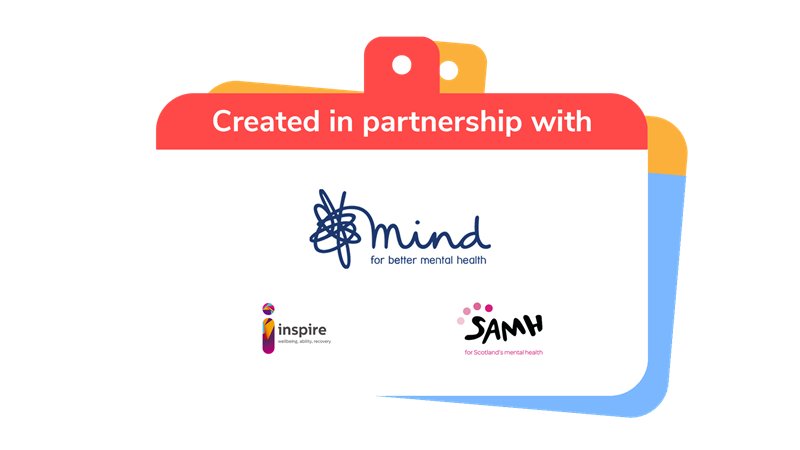
Become a walk and talk ambassador
You’ll need
- Coloured pens or pencils
- A4 card
- A4 paper
- Sticky notes
- Flipchart (optional)
Before you begin
- You’ll need some chatterboxes for this activity. If you’ve already done ‘Five ways to wellbeing chatterbox’, it’s up to you whether you make new chatterboxes or use the ones you already have. You may want to skip ‘Prepare the chatterboxes’ entirely, and just use the questions from ‘What makes a good chat?’ to guide conversations.
What makes a good chat?
- Everyone should take it in turns to think of questions they could use to start conversations about mental health or wellbeing. They should focus on open questions that get people talking because they can’t be answered with a simple ‘yes’ or ‘no’. For example, they could ask ‘where do you feel happiest?’, ‘who would you talk to if you needed support?’ or ‘how are you feeling today?’.
If people are struggling to come up with ideas, use the ‘Five ways to wellbeing’ sheet to help. Some of the best open questions start with words like what, when, who, why, how, or where.
- Everyone should write a question or two on a sticky note.
You could also use a big piece of paper or a whiteboard.
- Everyone should stick their sticky notes in the same place, to make a massive cloud of questions.
This is a great time for the person leading the activity to help everyone think about some of the things in ‘Make it accessible’, including getting more support for mental health problems.
- Everyone should choose their favourite questions, and think about how they might answer if a friend asked them.
Prepare the chatterboxes
- Everyone should follow the instructions in ‘Five ways to wellbeing chatterbox’ to make a chatterbox.
- Everyone should add the questions from ‘What makes a good chat’ into their chatterboxes.
Head outside
- The person leading the activity should remind everyone that they only have to share as much as they want to, and what to do if they hear something worrying.
If you’re not sure what to say, check out ‘Make it accessible’.
- Everyone should get into pairs and head outside for a walk.
You may want to plan a simple route in advance so everyone can focus on the conversation.
- As they’re walking, everyone should take it in turns to ask and answer questions using their chatterboxes. Both people could answer each question. Everyone should try to ask their partner follow-up questions to keep the conversation flowing.
- If there’s time, everyone could switch partners and go for another walk.
Take it to others
- The person leading the activity should explain that now that everyone’s practiced using their chatterboxes to start important conversations, it’s time to share it with their friends and families.
- Before the next meeting, everyone should use their chatterbox to ‘walk and talk’ with other people they know well, for example, a parent or carer, friend, or classmate. They should show the other people how to use the chatterbox, so they can ask questions too – it’s a conversation, not an interview! Most of the time, both people have plenty of great ideas to share.
People should only talk to people they know, trust, and feel safe chatting to.

This activity helps contribute towards some of the UN's Sustainable Development Goals. Find out more about the SDGs, and how Scouts across the world are getting involved.




Reflection
This activity was all about communicating. What was it like having a conversation about wellbeing and mental health? If people aren’t used to it, it may have felt a little odd at first. It’s good to talk about these things so everyone can help each other and people don’t feel alone. Did people find it easier to talk or to listen? How else could people communicate about the five ways to wellbeing (and the importance of talking about mental health)? What audiences could they reach?
This activity was also about caring. Everyone has mental health, so the five ways to wellbeing are for everyone (though, of course, everyone will find different things more helpful). Did talking about the five ways to wellbeing with other people help them? Did people have to think about their partner’s feelings during the conversation? How did they show that they were listening and caring? Did anyone learn anything new during this activity? What are people’s favourite ways to boost their wellbeing?
Safety
All activities must be safely managed. You must complete a thorough risk assessment and take appropriate steps to reduce risk. Use the safety checklist to help you plan and risk assess your activity. Always get approval for the activity, and have suitable supervision and an InTouch process.
- Hiking and walking
Follow the guidance for activities in Terrain Zero, or the guidance for each the adventurous activity.
- Road safety
Manage groups carefully when near or on roads. Consider adult supervision and additional equipment (such as lights and high visibility clothing) in your risk assessment.
Why not see if people want to pass on some of what they’ve learned? For example, they could record a video message about the importance of having conversations about mental health and post it online. Make sure you have the right consent before you film anything.
If some people aren’t confident writers, one person could write everyone’s questions down as they say them out loud in ‘What makes a good chat?’
Make sure you’ve got an accessible route for anyone who needs it – think about thinks like steps and lowered kerbs. If you’re not able to get outside for a walk for any reason, you could wander around your meeting place, or everyone could find a cosy, safe, spot to chat (why not get the blankets out?).
Mental health is complicated – positive wellbeing activities can’t always make mental health problems better (no matter how great they are). This isn’t anybody’s fault, and it’s always OK to need some more support for mental health problems. Remind people that talking to a trusted adult, a GP, or Childline are all great places to start.
Be sensitive if anyone has experience of mental health problems. Let them (and their parents or carers) know about the activity in advance and find out if there are any topics you should avoid. People only have to share as much as they want to. No one has to share their deepest secrets or feelings if they feel uncomfortable – they can still chat about their wellbeing and things that help on a day-to-day basis.
All Scout activities should be inclusive and accessible.
Why not use this activity as an icebreaker? It’s a great way for people to get to know each other, especially at an event like a camp. Bring some chatterboxes with you to get the conversations flowing.
You could keep track of people’s conversations with family and friends, for example, with a chart in your meeting place.
Discover more at https://www.mind.org.uk/







